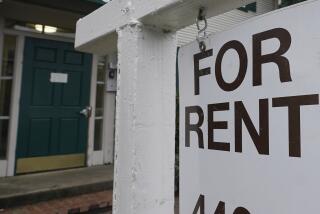Location, Not Low Rents, Cited as Ellis Act Lure : Santa Monica: Development potential is top factor in landlords’ filing to go out of business, study finds.
- Share via
The decision to remove properties from the rental housing market under the state Ellis Act is more likely based on location rather than low rents as previous studies had concluded, according to a new report released this week by the Santa Monica Rent Control Board.
The study of properties withdrawn from the market from July, 1986, to June, 1990, concluded that “the major factor in Ellis withdrawals is probably the development potential of the property activity.”
The study divided the city into seven areas and showed that units in commercial areas tended to have lower rents than those in other areas of the city. Mary Ann Yurkonis, the rent board administrator, said it was those low rents in commercial zones that caused prior reports to conclude that low rents were encouraging landlords to use the Ellis Act to go out of business.
The Ellis Act allows landlords to legally evict tenants and go out of business, and to develop the property under existing zoning.
“Now that we have looked at the data area by area, we see that once-sizeable Ellis activity in the downtown area has stopped,” Yurkonis said. “The highest Ellis activity is now occurring in areas that have higher rents on the whole.
“If Ellis was a function of low rents, you would see a great deal of activity in the Pico neighborhood, and there is very little.”
Yurkonis said that much of the new activity is occurring in the area north of Colorado Boulevard, where property values are higher than other parts of the city and where a flurry of condominium development is taking place.
As of June 30, owners of 203 properties with about 1,200 units had filed notices with the city of their intent to go out of business under the Ellis Act. But 28 of those notices were abandoned by owners or are in court, leaving 175 properties with 1,031 units.
Among the 175 properties is the 178-unit Sea Castle Apartments. Owners of the Sea Castle filed a notice in January but have not yet taken any action to evict tenants. The latest study did not include the Sea Castle because officials said its size and the inactivity by the owner would distort the findings.
But Carl Lambert, an attorney and landlord, questioned the conclusions and motivation of the report.
“It is not unusual that they would bend their reports to fit their agenda,” said Lambert, who had not yet read the report. “If they are saying that ‘high priced’ units are being lost, that’s an indication of how severe the economic shortfall is between rent allowed under rent control and the expenses to operate an apartment in Santa Monica.
“More importantly, that means that no building is safe from Ellis unless Proposition U passes, which would give landlords psychological and economic incentives to stay in business.”
The number of landlords filing notice to evict under the Ellis Act has slowed considerably since April. Lambert said that is because landlords are awaiting the outcome of the Nov. 6 election. On that ballot is Proposition U, a landlord-backed measure that would allow rents to increase to market levels on units that are vacated voluntarily.
The City Council, at the urging of Santa Monicans for Renters’ Rights, placed Proposition W on the ballot to counter the landlords’ measure. Prop W would also allow rents to increase upon voluntary vacancy, but only to specific higher levels that are still lower than market rates.
More to Read
Sign up for Essential California
The most important California stories and recommendations in your inbox every morning.
You may occasionally receive promotional content from the Los Angeles Times.






